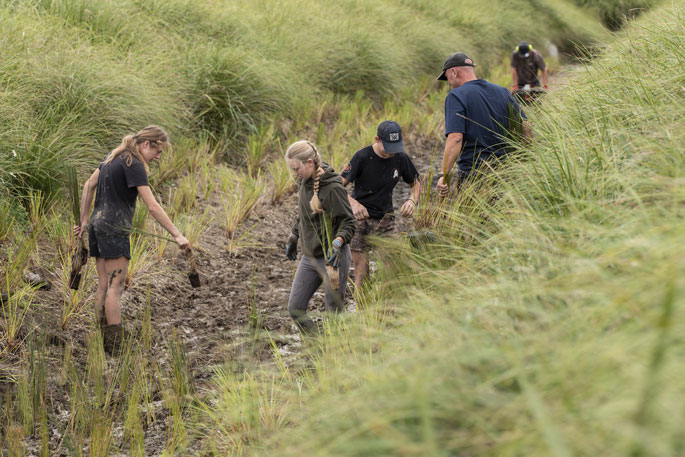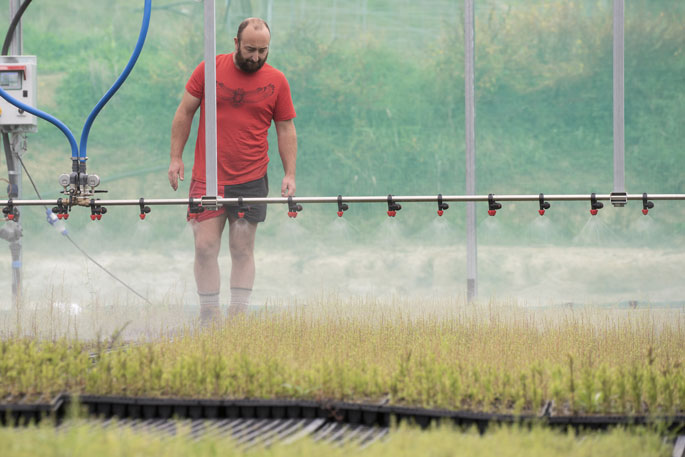With viticulturist great grandparents, market gardener grandparents, and farmer parents, it wasn't a surprise that Restore Native founder, Adam Thompson ended up becoming a grower himself.
After 15 years in finance as a mortgage broker, which he really enjoyed, he stepped back to owning a third share of the company he set up.
'We bought a 175-hectare farm outside Cambridge in 2018, running 250 beef cows, and I was farming alongside mortgage broking,” says Adam.
The need to retire some areas of his farm kickstarted Adam's lifelong interest in native plants and conservation.
He is known for starting Predator Free Cambridge in 2017, an operation aligned with the nationwide government and Department of Conservation initiative, Predator Free 2050.
'Initially funded by Adam, the group now has a full-time facilitator and has made hundreds of trap boxes that are distributed around the area to people willing to trap pests on their land.”
Planting trees
His property has 20-hectares of covenanted bush, which provides the perfect source of seed and fruits for Adam to collect and grow his own seedlings.
'I've always grown stuff, but this was on a new scale. It started off with 1000 trees grown, then 10,000, then 50,000 and so on until four years on since we started growing commercially we've now grown one million trees this year.”
Adam is using around two hectares of the farm for the native plant nursery and during the Covid lockdowns he spent the time building greenhouses on the land.
'I truly believed that the pandemic would be the end of my mortgage business and I decided to concentrate on getting the native plant nursery in shape for going into a larger scale operation.
'I was thankfully wrong about the mortgage business as two of the biggest years of growth that I have ever seen in the housing market followed Covid.”
 Adam Thompson runs his native plant nursery on two hectares of his farm. Photo: Catherine Fry.
Adam Thompson runs his native plant nursery on two hectares of his farm. Photo: Catherine Fry.
However by then, Adam was being slowly pulled towards his new venture and away from the life of finance.
'I love farming, I love native bush. I am doing my dream job and living my life aligned with my passion. It's in my blood and growing things brings a real sense of purpose.”
Growing natives
'I only grow natives, with a focus on finding easy, affordable options for farmers to retire land. I deal directly with my customers and there is no middleman.”
The yearly cycle in the nursery starts with seed collecting from various native plantings around the Waikato. Using local seed means that the trees will already be suitable for the environment they will eventually be planted in.
Sowing and germination occur mainly in autumn and Adam has invested in machinery, including an Italian precision seeder, to speed up and automate some of the processes. He says all the machinery has been well worth the investment.
'Larger seeds such as kahikatea, rimu and totara have to be sown by hand in boxes, which is more labour intensive, but these are trees that grow slowly and live a long time.”
Adam has a special customised seed raising mix for his natives. Once germinated the small plants are put into the greenhouses which have precision irrigation systems that can be adjusted to one millimetre an hour mimicking soft, gentle rain.
Plants are re-potted into larger pots over winter and spring and moved outside. They remain here for one to three years depending on their species.
'With young native plants, everything seems to want to kill them. Pest range from mammals, birds, insects, fungi and bacteria and each plant species has different threats. We walk the nursery every day and look at the plants as this way we catch issues early and can act.”
The goal is to try to minimise spraying and use organic-based products.
'I've been through the process for many years on my own land. I've lost plants and learned the hard way. This has helped us to develop techniques that are resilient and efficient on farms.
'Vigilance and knowledge of each species is very important, as is the huge amount of planning and variety of skills involved when starting a new project.”
Having established bush on his own land, plus acres of his more recent plantings and the nursery, means Adam has a living showroom onsite to show clients.
 All hands on deck with some planting. Photo: Catherine Fry.
All hands on deck with some planting. Photo: Catherine Fry.
Since 2019, Adam has expanded to 12 staff, rising to 16 at peak and dropping to eight during down time.
'Sometimes we just supply plants and give advice, but other times we prepare the site and carry out the planting. We can also maintain and monitor plantings until the trees are large enough to make it on their own.”
With a smile, Adam says that rain or shine, hot or cold, every day working in the nursery is a happy day, and he's well and truly in his happy place.



0 comments
Leave a Comment
You must be logged in to make a comment.